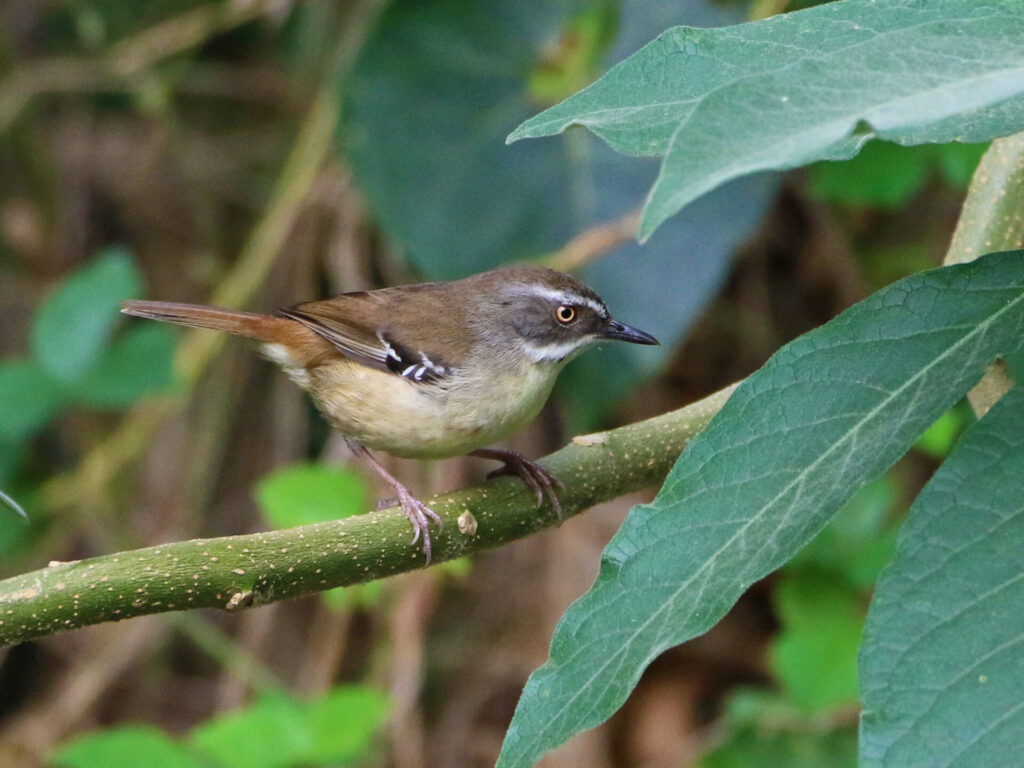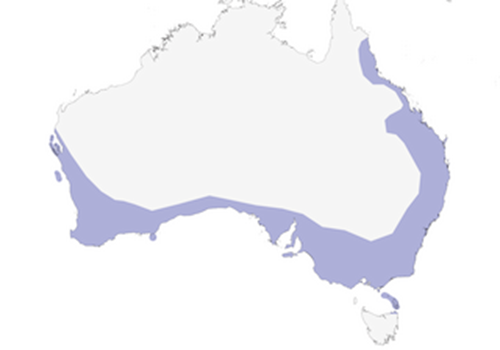
The White-browed Scrubwren is the most common and widespread of Australia’s five species of scrubwrens.
Described as a medium-sized scrubwren at 10.5 – 15cm, c. 14g, it is mostly dark olive-brown above, with a buff grey throat and flanks, and dull rufous belly and rump. The area around the eye between the lines is black, becoming greyer near the ear. Legs are pinkish-brown to dark brown. A strong white line above the eye and another below the eye, the whitish tips of the greater coverts and the light cream eye distinguish this species from the Large-billed Scrubwren (Sericornis magnirostris), and Yellow-throated Scrubwren (Neosericornis citreogularis), who both share part of its range.
White-browed Scrubwren males and females are similar, but the females are duller, particularly on the face. Immatures are also duller and their pattern is more diffuse. Subtropical and tropical populations are more yellow underneath with males having an almost black facial mask.

Habitat
The White-browed Scrubwren is able to thrive in a wide range of habitats including rainforest, open forest, woodlands and heaths. They prefer dense undergrowth and will occupy thickets of lantana (Lantana), blackberry (Rubus fruticosus) or other exotics. Usually seen in pairs or small groups.
Diet and Foraging
White-browed Scrubwrens spend much of their time on or near the ground feeding in the litter and low, dense vegetation. They feed mostly on insects and sometimes seeds. They forage mainly by gleaning, examining woody debris and leaf litter but also by probing and by moving fallen leaves. Often they are in mixed feeding flocks and are also seen in association with Superb Lyrebird (Menura novaehollandiae), Albert’s Lyrebird (Menura alberti) and Australian Logrunner (Orthonyx temminckii).

Range and Conservation Status
Common within its range which extends from northern Queensland, in a coastal band through South Australia to the mid West Australian coast, and Tasmania. Generally sedentary, the young and non-breeders do not usually disperse far.
Not globally threatened and considered secure but locally vulnerable to fire, land clearing and predation by feral animals.

Sounds and Vocal Behavior
Their presence is generally given away by its call which is a loud variable song that can be musical or harsh. Most have a scolding “tzz tzz tszz” alarm and they also use soft contact notes. During foraging, group-members are in constant vocal contact with calls ranging from soft when they are close or louder calls when separated.
Breeding
Breeding occurs mainly Aug–Jan but can be in any month; with several broods in a season. The mating system includes the female having one or more male partners. Breeding can be a pair, or a co-operative group consisting of breeding female, with a dominant male and up to four helpers (usually from previous broods or siblings).
The nest is a large ball of grass, small twigs and roots and is hidden low in shrubs, grass, tree hollows and undergrowth. The domed nest has a hooded side entrance and is usually lined with feathers and/or hair.
The clutch of 2–3 eggs, grey-white to pale buff with dark brown, black or purple blotches and spots, are incubated by female for between 17-22 days. The chicks are fed by both parents and by any helpers present; young are fed by adults for 6–7 weeks after fledging and stay in the territory for a further 4 weeks and often longer.
Nests can be parasitized by Fan-tailed Cuckoo (Cacomantis flabelliformis), Horsfield’s Bronze-cuckoo (Chrysococcyx basalis) and Black-eared Cuckoo (Chrysococcyx osculans).
Lifespan
In ringing (banding) studies a bird of at least 16 years 2 months was recorded.
Reference
Gregory, P. (2020). White-browed Scrubwren (Sericornis frontalis), version 1.0. In Birds of the World (J. del Hoyo, A. Elliott, J. Sargatal, D. A. Christie, and E. de Juana, Editors). Cornell Lab of Ornithology, Ithaca, NY, USA.


